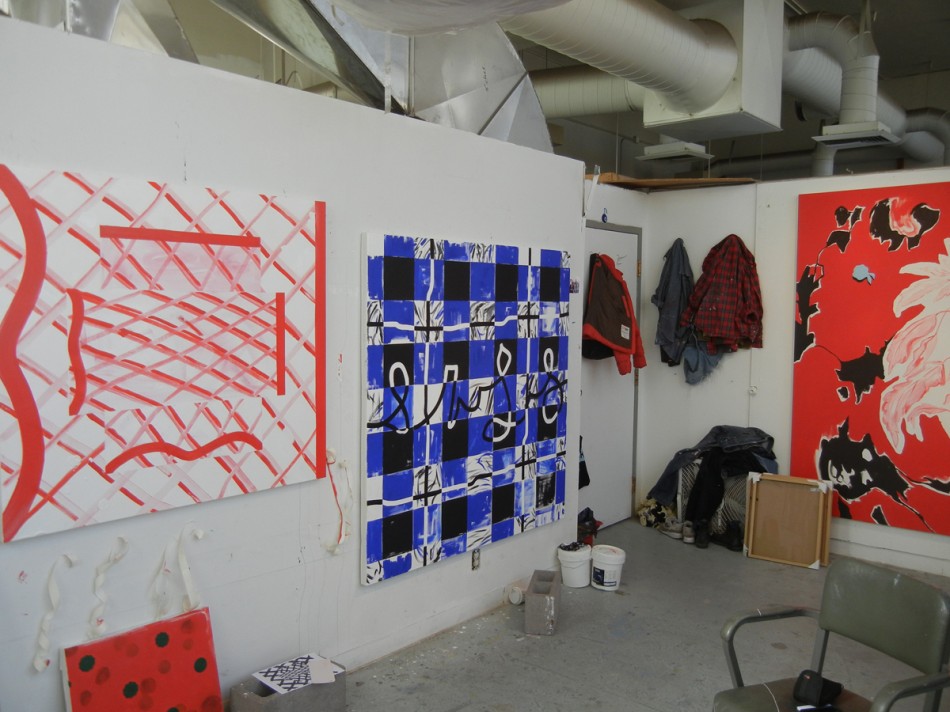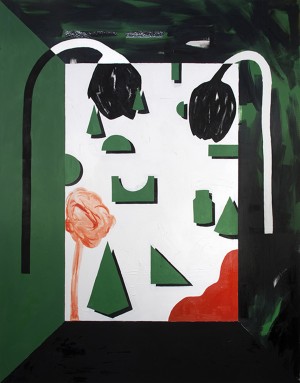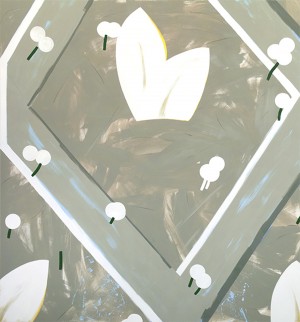
Natalie Smith's painting studio
On Abstract Painting and Impulse: A Talk with Natalie Smith
While the widening inventions in contemporary abstraction have renewed an interest in painting, abstraction’s recent ascension has also dredged up a fatuous debate about painting’s use-value, specifically in regard to discriminating between good and bad painting. Adding to that, we have the burden of trudging through the hollow of provisional painting—the Raphael Rubinstein-coined, lightweight painting movement that embraces the “casual, dashed-off, tentative, unfinished or self-canceling”—which has attached itself to contemporary painting like a tiny anchor on a giant ship.
These thoughts dribbled through my head after talking with University of New Mexico grad student Natalie Smith about her painting and upcoming MFA thesis exhibition, Lodi, at SCA Contemporary Art. Smith makes chancy, abstract paintings that probe their “whatness” through a formal investigation into their own development. She is part of a wave of young painters continuing to test the limits of painterly inventiveness and the potentiality of completion. These painters have individualistic approaches to image-making and expect a serious reading of contemporary abstraction as a unique analog to their personal experiences, not as a generic rumination on sketchy failures or false starts.
The paintings in Smith’s studio—the paintings heading to her MFA installation—are good, heavy things, jammed with art history and built on a design strategy that propels them toward a goal, an end. With a reliance on rich color combinations that allow space for experimentation in other areas (shape, line, pattern), the resulting work challenges inherited ideas of what a painting can do. I spoke with Smith in her studio last month.
How did you choose painting as your medium?
It’s the work that I love the most, the work that I love to look at the most. The medium seems to have the most possibilities, in some way. And coming out of this side practice of assembling and collaging and building materials, I think there were limits in working that way.
Limits you don’t find as quickly in painting?
Limits that don’t seem to exist in painting at all. The limits with painting are: a rectangle, a canvas, whatever…the object. Everything else just seems limitless. The other work was designed and cohesive. In painting, there’s a point where you cannot design anymore; the paint itself — and problems that happen — come up again and again and there will always be something to work up against. That happens whether you like it or not.
Do you remember a painting or something you saw that just clicked for you, or do you remember that thing you saw that made you say, I want to do that?
Yeah. I think it keeps happening. Design was what kind of turned me on as a younger person, and I think it really has been quite recently that painting was important. When I was younger—like 18 and 19—I really loved Jonathan Lasker, and I loved looking at early Rothko, Miro and Matisse. Lately, I feel like I’ve been having that moment and thinking this is what I need to do … looking at Chris Martin and Charline von Heyl…Moira Dryer recently…a lot of . . . outsider art. But I think the real clicking happened not in a moment or seeing an exhibition, but when I got my first digital camera and really started taking pictures. When I was in London at Goldsmiths I felt really intimidated by the other painters there and the really amazing paintings they were making, I would just leave the studio and take the tube up from New Cross into North London and walk around Regents Park or Hampstead Heath for hours. I don’t think I really knew what to make then and materials were so expensive and it felt much more productive to just be. It was very adult feeling and I was pretty young then. I think that kind of meditative walking, processing things in the way that you can do when you’re alone, and being totally anonymous…putting things together—like seeing some sunlight pass over a crosswalk and snapping a photo and then doing it again and again. Finding and building imagery with the camera. I think I really learned how to look, about how art making is about discovering and uncovering things..
I want these paintings to be about people.
I like to think about them being really personal paintings, and I guess at moments thinking about them as portraits. There’s kind of a sense of nostalgia and referencing of the late 60s and early 70s.
Do you build from sketches first?
Yeah, I’ll build a drawing and I’ve mostly been doing that on Photoshop lately and then playing around with my palette digitally. Sometimes I’ll (physically) do something to shift things (on the canvas) like put a color down or make a mark that wasn’t part of my thinking.
It’s hard to leave things just be. I want it to get a little fucked up or want to see what happens if I just like go with an impulse, even if I know it’s a bad one. That’s even better.
The color I think is really interesting. How do you approach color?
I can fall back on primary colors. It’s a real comfort zone for me. Sometimes I want colors to be less specific. Often times, I want the color to be really neutral or subvert the imagery in a way. I often come back to this idea of restraint in my work.
Restraint’s an interesting word…There is something that’s necessarily left out.
I think it’s something. What’s pleasure or what’s problematic in the work? I think in terms of what the avant-garde is right now… this is kind of a strange moment…I know there’s been the conversation about provisional painting for instance. People have talked about my work in those terms — . . . the materiality of the paint or stylistically or the gesture. It’s not absolute.
You’ve been here three years…what’s changed? How has your time at UNM changed how you work?
The really, really cheesy answer is I think I became an artist. I look at the other 11 or so MFAs that I came in with, and they pretty much had it figured out from the beginning. I think I started working right away, but I really had no clue what kind of artist I wanted to be…and maybe I think I’m closer now than I’ve ever been.
Lodi



